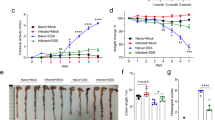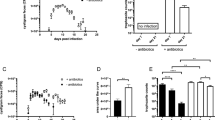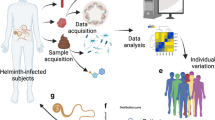Abstract
Heligmosomoides polygyrus bakeri (Hpb) infection in mice is a convenient model for studying the pathophysiology and immunology of gastrointestinal (GI) helminth infection. Hpb infection suppresses immune responses to bystander antigens and unrelated pathogens, and it slows the progression and modifies the outcome of immune-mediated diseases. Hpb-derived excretory-secretory (ES) products potently modulate CD4+ helper T cell (TH) responses by inducing regulatory T cells, tolerogenic dendritic cells (DCs) and immunoregulatory cytokines. This observation has spiked interest in identifying the immunomodulatory molecules, especially proteins, in ES products from Hpb and other GI nematodes for development as novel therapies to treat individuals with immune-mediated diseases, such as inflammatory bowel diseases (IBDs). In this protocol, we describe how to (i) maintain Hpb in the laboratory for experimental infections, (ii) collect adult worms from infected mice to generate ES products and (iii) evaluate the modulatory effects of ES products on toll-like receptor (TLR) ligand–induced maturation of CD11c+ DCs. The three major sections of the PROCEDURE can be used independently, and they require ∼6, 10 and 27 h, respectively. Although other methods use a modified Baermann apparatus to collect Hpb adult worms, we describe a method that involves dissection of adult worms from intestinal tissue. The protocol will be useful to investigators studying the host-parasite interface and identifying and analyzing helminth-derived molecules with therapeutic potential.
This is a preview of subscription content, access via your institution
Access options
Subscribe to this journal
Receive 12 print issues and online access
$259.00 per year
only $21.58 per issue
Buy this article
- Purchase on Springer Link
- Instant access to full article PDF
Prices may be subject to local taxes which are calculated during checkout





Similar content being viewed by others
References
Fleming, J.O. & Cook, T.D. Multiple sclerosis and the hygiene hypothesis. Neurology 67, 2085–2086 (2006).
Dunne, D.W. & Cooke, A. A worm's eye view of the immune system: consequences for evolution of human autoimmune disease. Nat. Rev. Immunol. 5, 420–426 (2005).
Molodecky, N.A. et al. Increasing incidence and prevalence of the inflammatory bowel diseases with time, based on systematic review. Gastroenterology 142, 46–54 (2012).
Yazdanbakhsh, M., Kremsner, P.G. & van Ree, R. Allergy, parasites, and the hygiene hypothesis. Science 296, 490–494 (2002).
McCarty, T.R., Turkeltaub, J.A. & Hotez, P.J. Global progress towards eliminating gastrointestinal helminth infections. Curr. Opin. Gastroenterol. 30, 18–24 (2014).
Artis, D. Translatability of helminth therapy. Int. J. Parasitol. 43, 189 (2013).
Weinstock, J.V. & Elliott, D.E. Translatability of helminth therapy in inflammatory bowel diseases. Int. J. Parasitol. 43, 245–251 (2013).
Maizels, R.M. et al. Helminth parasites – masters of regulation. Immunol. Rev. 201, 89–116 (2004).
Johnson, M.J.G., MacDonald, J.A. & McKay, D.M. Parasitic helminths: a pharmacopoeia of anti-inflammatory molecules. Parasitology 136, 125–147 (2008).
Hewitson, J.P., Grainger, J.R. & Maizels, R.M. Helminth immunoregulation: the role of parasite secreted proteins in modulating host immunity. Mol. Biochem. Parasitol. 167, 1–11 (2009).
Segura, M., Su, Z., Piccirillo, C. & Stevenson, M.M. Impairment of dendritic cell function by excretory-secretory products: a potential mechanism for nematode-induced immunosuppression. Eur. J. Immunol. 37, 1887–1904 (2007).
Moreno, Y. et al. Proteomic analysis of excretory-secretory products of Heligmosomoides polygyrus assessed with next-generation sequencing transcriptomic information. PLoS Negl. Trop. Dis. 5, e1370 (2011).
Camberis, M., Le Gros, G. & Urban, J. Jr. Animal models of Nippostrongylus brasiliensis and Heligmosomoides polygyrus. Curr. Protoc. Immunol. S55, 19.12.1–19.12.27 (2003).
Hewitson, J.P. et al. Proteomic analysis of secretory products from the model gastrointestinal nematode Heligmosomoides polygyrus reveals dominance of venom allergen-like (VAL) proteins. J. Proteomics 74, 1573–1594 (2011).
Finkelman, F.D. et al. Cytokine regulation of host defense against parasitic gastrointestinal nematodes: lessons from studies with rodent models. Annu. Rev. Immunol. 15, 505–533 (1997).
Gause, W.C., Urban, J.F. & Stadecker, M.J. The immune response to parasitic helminths: insights from murine models. Trends Immunol. 24, 269–277 (2003).
Reynolds, L.A., Filbey, K.J. & Maizels, R.M. Immunity to the model intestinal helminth parasite Heligmosomoides polygyrus. Semin. Immunopathol. 34, 829–846 (2012).
Ben-Smith, A., Wahid, F.N., Lammas, D.A. & Behnke, J.M. The relationship between circulating and intestinal Heligmosomoides polygyrus-specific IgG1 and IgA and resistance to primary infection. Parasite Immunol. 21, 383–395 (1999).
Robinson, M., Wahid, F., Behnke, J.M. & Gilbert, F.S. Immunological relationships during primary infection with Heligmosomoides polygyrus (Nematospiroides dubius): dose-dependent expulsion of adult worms. Parasitology 98, 115–124 (1989).
Menge, D.M. et al. Mapping of chromosomal regions influencing immunological responses to gastrointestinal nematode infections in mice. Parasite Immunol. 25, 341–349 (2003).
Behnke, J.M. & Robinson, M. Genetic control of immunity to Nematospiroides dubius: a 9-day anthelmintic abbreviated immunizing regime which separates weak and strong responder stains of mice. Parasite Immunol. 7, 235–253 (1985).
Sukhdeo, M.V., O'Grady, R.T. & Hsu, S.C. The site selected by the larvae of Heligmosomoides polygyrus. J. Helminthol. 58, 19–23 (1984).
Behnke, J.M. et al. Immunological relationships during primary infection with Heligmosomoides polygyrus (Nematospiroides dubius): downregulation of specific cytokine secretion (IL-9 and IL-10) correlates with poor mastocytosis and chronic survival of adult worms. Parasite Immunol. 15, 415–421 (1993).
Wahid, F.N. et al. Immunological relations during primary infection with Heligmosomoides polygyrus: TH2 cytokines and primary response phenotype. Parasitology 108, 461–471 (1994).
Sutton, T.L. et al. Anti-inflammatory mechanisms of enteric Heligmosomoides polygyrus infection against trinitrobenzene sulfonic acid-induced colitis in a murine model. Infect. Immun. 76, 4772–4782 (2008).
Su, Z. et al. Impairment of protective immunity to blood-stage malaria by concurrent nematode infection. Infect. Immun. 73, 3531–3539 (2005).
Weng, M. et al. Alternatively activated macrophages in intestinal helminth infection: effects on concurrent bacterial colitis. J. Immunol. 179, 4721–4731 (2007).
Blum, A.M. et al. Heligmosomoides polygyrus bakeri induces tolerogenic dendritic cells that block colitis and prevent antigen-specific gut T cell responses. J. Immunol. 189, 2512–2520 (2012).
Anthony, R.M. et al. Memory TH2 cells induce alternatively activated macrophages to mediate protection against nematode parasites. Nat. Med. 12, 955–960 (2006).
Esser-von Bieren, J. et al. Antibodies trap tissue migrating helminth larvae and prevent tissue damage by driving IL-4Rα–independent alternative differentiation of macrophages. PLoS Pathog. 9, e1003771 (2013).
Salgame, P., Yap, G.S. & Gause, W.C. Effect of helminth-induced immunity on infections with microbial pathogens. Nat. Immunol. 14, 1118–1126 (2013).
McSorley, H.J., Hewitson, J.P. & Maizels, R.M. Immunomodulation by helminth parasites: defining mechanisms and mediators. Int. J. Parasitol. 43, 301 (2013).
Grainger, J.R. et al. Helminth secretions induce de novo T cell Foxp3 expression and regulatory function through the TGF-β pathway. J. Exp. Med. 207, 2331–2341 (2010).
Wilson, M.S. et al. Suppression of allergic airway inflammation by helminth-induced regulatory cells. J. Exp. Med. 202, 1199–1212.
Rzepecka, J., Donskow-Schmelter, K. & Doligalska, M. Heligmosomoides polygyrus infection down-regulates eotaxin concentration and CCR3 expression on lung eosinophils in murine allergic pulmonary inflammation. Parasite Immunol. 29, 405–413 (2007).
McSorley, H.J. et al. Suppression of type 2 immunity and allergic airway inflammation by secreted products of the helminth Heligmosomoides polygyrus. Eur. J. Immunol. 42, 2667–2682 (2012).
Crawford, C., Behnke, J.M. & Pritchard, D.I. Suppression of heterologous immunity by Nematospiroides dubuis antigens in vitro. Int. J. Parasitol. 19, 29–34 (1989).
Monroy, F.G., Dobson, C. & Adams, J.H. Low-molecular-weight immunosuppressors secreted by adult Nematospiroides dubuis. Int. J. Parasitol. 19, 125–127 (1989).
Telford, G. et al. Heligmosomoides polygyrus immunomodulatory factor (IMF) targets T- lymphocytes. Parasite Immunol. 20, 601–611 (1998).
Hewitson, J.P. et al. The secretome of the filarial parasite, Brugia malayi: proteomic profile of adult excretory-secretory products. Mol. Biochem. Parasitol. 160, 8–21 (2008).
Moreno, Y. & Geary, T.G. Stage- and gender-specific proteomic analysis of Brugia malayi excretory-secretory products. PLoS Negl. Trop. Dis. 2, e326 (2008).
Bennuru, S. et al. Brugia malayi excreted/secreted proteins at the host/parasite interface: stage- and gender-specific proteomic profiling. PLoS Negl. Trop. Dis. 3, e3410 (2009).
Robinson, M.W. et al. An integrated transcriptomics and proteomics analysis of the secretome of the helminth pathogen Fasciola hepatica: proteins associated with invasion and infection of the mammalian host. Mol. Cell. Proteomics 8, 1891–1907 (2009).
Yatsuda, A.P. et al. Comprehensive analysis of the secreted proteins of the parasite Haemonchus contortus reveals extensive sequence variation and differential immune recognition. J. Biol. Chem. 278, 16941–16951 (2003).
Hewitson, J.P. et al. Secretion of protective antigens by tissue-stage nematode larvae revealed by proteomic analysis and vaccination-induced sterile immunity. PLoS Pathog. 9, e1003492 (2013).
Wang, T. et al. Proteomic analysis of the excretory-secretory products from larval stages of Ascaris suum reveals high abundance of glycosyl hydrolases. PLoS Negl. Trop. Dis. 7, e2467 (2013).
Baermann, G. Eine einfache methode zur auffindung von Ankylostomum (nematoden) larven in erdproben. Geneesk. Tijdschr. Ned-Indië 57, 131–137 (1917).
van Bezooijen, J. Methods and Techniques for Nematology (revised edition) (Department of Nematology, Agricultural University, Wageningen, Holland 2006).
Holland, M.J., Harcus, Y.M., Riches, P.L. & Maizels, R.M. Proteins secreted by the parasitic nematode Nippostrongylus brasiliensis act as adjuvants for Th2 responses. Eur. J. Immunol. 30, 1977–1987 (2000).
Adams, J.H., Monroy, F.G., East, J. & Dobson, C. Surface and excretory/secretory antigens of Nematospiroides dubius. Immuno. Cell Biol. 65, 393–397 (1987).
Hewitson, J.P. et al. Heligmosomoides polygyrus elicits a dominant nonprotective antibody response directed against restricted glycan and peptide epitopes. J. Immunol. 187, 4764–4777 (2011).
Stockinger, B. et al. B cells solicit their own help from T cells. J. Exp. Med. 183, 891–899 (1996).
Cantacessi, C. et al. The transcriptome of Trichuris suis – first molecular insights into a parasite with curative properties for key immune diseases in humans. PLoS ONE 6, e23590 (2011).
Massacand, J.C. et al. Helminth products bypass the need for TSLP in TH2 immune responses by directly modulating dendritic cell function. Proc. Natl. Acad. Sci. USA 106, 13968–13973 (2009).
Klaver, E.J. et al. Trichuris suis–induced modulation of human dendritic cell function is glycan-mediated. Int. J. Parasitol. 43, 191–200 (2013).
Twohy, C.W., Duran, A.P. & Munson, T.E. Endotoxin contamination of parenteral drugs and radiopharmaceuticals as determined by the Limulus amebocyte lysate method. J. Parenter. Sci. Technol. 38, 190–201 (1984).
Ministry of Agriculture, Fisheries and Food. Manual of Veterinary Parasitological Laboratory Techniques (Reference Book 418), 3rd edn., (Publisher: Her Majesty's Stationery Officer (HMSO), London 1986).
Bradford, M.M. A rapid and sensitive method for the quantitation of microgram quantitites of protein utilizing the principle of protein-dye binding. Anal. Biochem. 72, 248–254 (1976).
Inaba, K.M. et al. Generation of large numbers of dendritic cells from mouse bone marrow cultures supplemented with granulocytes-macrophage colony-stimulating factors. J. Exp. Med. 176, 1693–1702 (1992).
Lutz, M.B. et al. An advanced culture method for generating large quantities of highly pure dendritic cells from mouse bone marrow. J. Immunol. Methods 223, 77–92 (1999).
BD Biosciences. Immunofluorescent Staining of Mouse and Rat Leukocytes http://www.bdbiosciences.com/ca/resources/protocols/mouse_rat_leukocytes.jsp.
Acknowledgements
R.M.V. is a recipient of a Studentship (2013–2014) from the Research Institute of the McGill University Health Centre. The work in our laboratories is supported by funding from the Natural Sciences and Engineering Research Council of Canada (NSERC) to M.S.; the Canadian Institutes of Health Research (CIHR) (MOP 94589) to A.J.; NSERC and Canada Research Chairs grants to T.G.G.; and CIHR (MOP 81169 and MOP 130369) to M.M.S. The Centre for Host-Parasite Interactions is supported by funding from the Fonds de Québec de recherche sur la nature et les technologies.
Author information
Authors and Affiliations
Contributions
All authors contributed extensively to this manuscript. R.M.V. wrote the first draft and provided examples of original data for the ANTICIPATED RESULTS section. M.S. contributed to the development of the procedures for the adult worm collection and ES production, the generation of BMDCs and the evaluation of ES products on DC function. M.T. contributed to the development of the procedures for maintaining the Hpb parasite, for egg collection to obtain larvae for infection and to obtain ES products, and for collection of adult worms. A.J. and T.G.G. provided expert advice on the procedures and contributed significantly to finalizing the submitted manuscript. A.J., T.G.G. and M.M.S. jointly conceived the idea for the manuscript. M.M.S. provided supervision to R.M.V. in preparing the draft and wrote and revised the final manuscript.
Corresponding author
Ethics declarations
Competing interests
The authors declare no competing financial interests.
Supplementary information
Supplementary Table 1
Protein production by Hpb adult worm in culture. (PDF 84 kb)
Rights and permissions
About this article
Cite this article
Valanparambil, R., Segura, M., Tam, M. et al. Production and analysis of immunomodulatory excretory-secretory products from the mouse gastrointestinal nematode Heligmosomoides polygyrus bakeri. Nat Protoc 9, 2740–2754 (2014). https://doi.org/10.1038/nprot.2014.184
Published:
Issue Date:
DOI: https://doi.org/10.1038/nprot.2014.184
This article is cited by
-
Maternal gastrointestinal nematode infection enhances spatial memory of uninfected juvenile mouse pups
Scientific Reports (2022)
-
Proteomic analysis revealed T cell hyporesponsiveness induced by Haemonchus contortus excretory and secretory proteins
Veterinary Research (2020)
-
Immunomodulatory action of excretory-secretory products of Angiostrongylus cantonensis in a mouse tumour model
Parasitology Research (2020)
-
Of dogs and hookworms: man’s best friend and his parasites as a model for translational biomedical research
Parasites & Vectors (2018)
-
Analysis of the Trichuris suis excretory/secretory proteins as a function of life cycle stage and their immunomodulatory properties
Scientific Reports (2018)
Comments
By submitting a comment you agree to abide by our Terms and Community Guidelines. If you find something abusive or that does not comply with our terms or guidelines please flag it as inappropriate.



